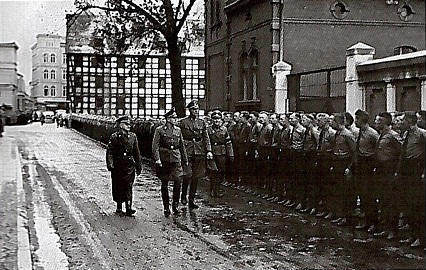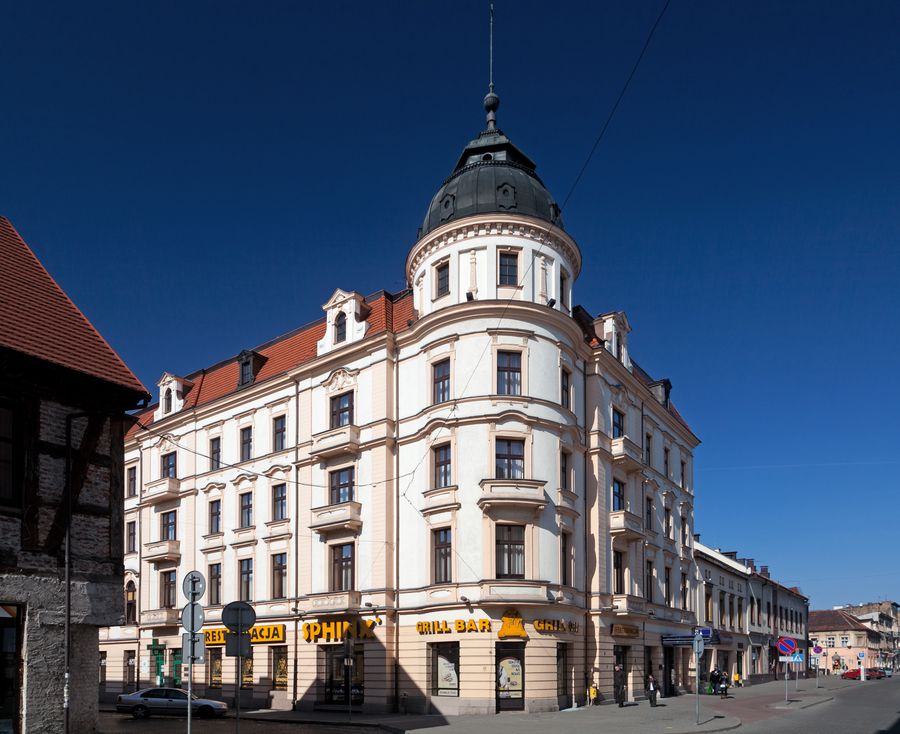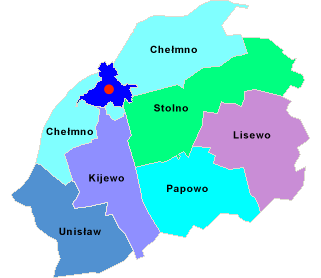|
Płutowo
Płutowo () is a village in the administrative district of Gmina Kijewo Królewskie, within Chełmno County, Kuyavian-Pomeranian Voivodeship, in north-central Poland. North of Płutowo village there is the Płutowo Nature Reserve with a total area of , which was established in 1963 for the protection of a rare ecosystem along a ravine above the Vistula river. The length of the ravine is 1.2 km and its depth around 57 metres from the top down to the water level. World War II In the fall of 1939 following the invasion of Poland the Nazi German occupational authorities set up a temporary concentration camp in Płutowo at a manor once owned by von Alvensleben family. The Polish prisoners brought to the camp came from the area of Ziemia chełmińska (Chełmno land). Over 200 victims were murdered at a nearby forest by the German ''Volksdeutscher Selbstschutz The ''Volksdeutscher Selbstschutz'' was an ethnic German self-protection militia, a paramilitary organization consisting ... [...More Info...] [...Related Items...] OR: [Wikipedia] [Google] [Baidu] |
Volksdeutscher Selbstschutz
The ''Volksdeutscher Selbstschutz'' was an ethnic German self-protection militia, a paramilitary organization consisting of ethnic German ('' Volksdeutsche'') mobilized from among the German minority in Poland. The ''Volksdeutscher Selbstschutz'' operated before, and during the opening stages of, World War II in the western half of Poland and were responsible for, and took part in, massacres of Poles, along with '' SS Einsatzgruppen''. Selbstschutz counted circa 100,000 members, who formed greater part of German minority members "fit for action". Background Ethnic Germans with Polish citizenship had been trained in the Third Reich in various sabotage methods and guerilla tactics. Before the war began, ''Selbstschutz'' activists from Poland compiled lists of Poles who were to be removed or executed in Operation Tannenberg. The list was distributed among Nazi death squads as the Special Prosecution Book-Poland (Germ. Sonderfahndungsbuch Polen). In the interwar period, the G ... [...More Info...] [...Related Items...] OR: [Wikipedia] [Google] [Baidu] |
Gmina Kijewo Królewskie
__NOTOC__ Gmina Kijewo Królewskie is a rural gmina (administrative district) in Chełmno County, Kuyavian-Pomeranian Voivodeship, in north-central Poland. Its seat is the village of Kijewo Królewskie, which lies approximately south of Chełmno, north-west of Toruń, and north-east of Bydgoszcz. The gmina covers an area of , and as of 2006 its total population is 4,294. Villages Gmina Kijewo Królewskie contains the villages and settlements of Bągart, Bajerze, Brzozowo, Dorposz Szlachecki, Kiełp, Kijewo Królewskie, Kijewo Szlacheckie, Płutowo, Szymborno, Trzebcz Królewski, Trzebcz Szlachecki and Watorowo. Neighbouring gminas Gmina Kijewo Królewskie is bordered by the town of Chełmno and by the gminas of Chełmno, Chełmża Chełmża (german: Kulmsee, earlier ''Culmsee''), is a town in north-central Poland, in the Toruń County, Kuyavian-Pomeranian Voivodeship. It is located at around . It is one of the historic centers of Chełmno Land. Geography The town ... [...More Info...] [...Related Items...] OR: [Wikipedia] [Google] [Baidu] |
Countries Of The World
The following is a list providing an overview of sovereign states around the world with information on their status and recognition of their sovereignty. The 206 listed states can be divided into three categories based on membership within the United Nations System: 193 member states of the United Nations, UN member states, 2 United Nations General Assembly observers#Present non-member observers, UN General Assembly non-member observer states, and 11 other states. The ''sovereignty dispute'' column indicates states having undisputed sovereignty (188 states, of which there are 187 UN member states and 1 UN General Assembly non-member observer state), states having disputed sovereignty (16 states, of which there are 6 UN member states, 1 UN General Assembly non-member observer state, and 9 de facto states), and states having a political status of the Cook Islands and Niue, special political status (2 states, both in associated state, free association with New Zealand). Compi ... [...More Info...] [...Related Items...] OR: [Wikipedia] [Google] [Baidu] |
Voivodeships Of Poland
A voivodeship (; pl, województwo ; plural: ) is the highest-level administrative division of Poland, corresponding to a province in many other countries. The term has been in use since the 14th century and is commonly translated into English as "province". The Polish local government reforms adopted in 1998, which went into effect on 1 January 1999, created sixteen new voivodeships. These replaced the 49 former voivodeships that had existed from 1 July 1975, and bear a greater resemblance (in territory, but not in name) to the voivodeships that existed between 1950 and 1975. Today's voivodeships are mostly named after historical and geographical regions, while those prior to 1998 generally took their names from the cities on which they were centered. The new units range in area from under (Opole Voivodeship) to over (Masovian Voivodeship), and in population from nearly one million (Opole Voivodeship) to over five million (Masovian Voivodeship). Administrative authority at th ... [...More Info...] [...Related Items...] OR: [Wikipedia] [Google] [Baidu] |
Kuyavian-Pomeranian Voivodeship
Kuyavian-Pomeranian Voivodeship, also known as Cuiavian-Pomeranian Voivodeship or simply Kujawsko-Pomorskie, or Kujawy-Pomerania Province ( pl, województwo kujawsko-pomorskie ) is one of the 16 voivodeships (provinces) into which Poland is divided. It was created on 1 January 1999 and is situated in mid-northern Poland, on the boundary between the two historic regions from which it takes its name: Kuyavia ( pl, Kujawy) and Pomerania ( pl, Pomorze). Its two chief cities, serving as the province's joint capitals, are Bydgoszcz and Toruń. History The Kuyavian-Pomeranian Voivodeship was created on 1 January 1999, as a result of the Polish local government reforms adopted in 1998. It consisted of territory from the former Bydgoszcz, Toruń and Włocławek Voivodeships. The area now known as Kuyavia-Pomerania was previously divided between the region of Kuyavia and the Polish fiefdom of Royal Prussia. Of the two principal cities of today's Kuyavian-Pomeranian voivodeship, one ( Byd ... [...More Info...] [...Related Items...] OR: [Wikipedia] [Google] [Baidu] |
Powiat
A ''powiat'' (pronounced ; Polish plural: ''powiaty'') is the second-level unit of local government and administration in Poland, equivalent to a county, district or prefecture ( LAU-1, formerly NUTS-4) in other countries. The term "''powiat''" is most often translated into English as "county" or "district" (sometimes "poviat"). In historical contexts this may be confusing because the Polish term ''hrabstwo'' (an administrative unit administered/owned by a ''hrabia'' (count) is also literally translated as "county". A ''powiat'' is part of a larger unit, the voivodeship (Polish ''województwo'') or province. A ''powiat'' is usually subdivided into '' gmina''s (in English, often referred to as "communes" or "municipalities"). Major towns and cities, however, function as separate counties in their own right, without subdivision into ''gmina''s. They are termed " city counties" (''powiaty grodzkie'' or, more formally, ''miasta na prawach powiatu'') and have roughly the same ... [...More Info...] [...Related Items...] OR: [Wikipedia] [Google] [Baidu] |
Chełmno County
Chełmno County ( pl, powiat chełmiński) is a unit of territorial administration and local government (powiat) in Kuyavian-Pomeranian Voivodeship, north-central Poland. It came into being on 1 January 1999, as a result of the Polish local government reforms adopted in 1998. Its administrative seat and only town is Chełmno, which lies north of Toruń and north-east of Bydgoszcz. The county covers an area of . As of 2019 its total population is 52,018, out of which the population of Chełmno is 19,605 and the rural population is 32,413. The county includes the protected area called Chełmno Landscape Park, which stretches along the right bank of the Vistula river. Neighbouring counties Chełmno County is bordered by Świecie County to the north, Grudziądz County and Wąbrzeźno County to the east, Toruń County to the south, and Bydgoszcz County to the south-west. Administrative division The county is subdivided into seven gmina The gmina (Polish: , plural ''gminy'' , from ... [...More Info...] [...Related Items...] OR: [Wikipedia] [Google] [Baidu] |
Gmina
The gmina (Polish: , plural ''gminy'' , from German ''Gemeinde'' meaning ''commune'') is the principal unit of the administrative division of Poland, similar to a municipality. , there were 2,477 gminas throughout the country, encompassing over 43,000 villages. 940 gminas include cities and towns, with 302 among them constituting an independent urban gmina ( pl, gmina miejska) consisting solely of a standalone town or one of the 107 cities, the latter governed by a city mayor (''prezydent miasta''). The gmina has been the basic unit of territorial division in Poland since 1974, when it replaced the smaller gromada (cluster). Three or more gminas make up a higher level unit called powiat, except for those holding the status of a city with powiat rights. Each and every powiat has the seat in a city or town, in the latter case either an urban gmina or a part of an urban-rural one. Types There are three types of gmina: #302 urban gmina ( pl, gmina miejska) constituted either by a sta ... [...More Info...] [...Related Items...] OR: [Wikipedia] [Google] [Baidu] |
Ecosystem
An ecosystem (or ecological system) consists of all the organisms and the physical environment with which they interact. These biotic and abiotic components are linked together through nutrient cycles and energy flows. Energy enters the system through photosynthesis and is incorporated into plant tissue. By feeding on plants and on one another, animals play an important role in the movement of matter and energy through the system. They also influence the quantity of plant and microbial biomass present. By breaking down dead organic matter, decomposers release carbon back to the atmosphere and facilitate nutrient cycling by converting nutrients stored in dead biomass back to a form that can be readily used by plants and microbes. Ecosystems are controlled by external and internal factors. External factors such as climate, parent material which forms the soil and topography, control the overall structure of an ecosystem but are not themselves influenced by the ecosystem. ... [...More Info...] [...Related Items...] OR: [Wikipedia] [Google] [Baidu] |
Vistula
The Vistula (; pl, Wisła, ) is the longest river in Poland and the ninth-longest river in Europe, at in length. The drainage basin, reaching into three other nations, covers , of which is in Poland. The Vistula rises at Barania Góra in the south of Poland, above sea level in the Silesian Beskids (western part of Carpathian Mountains), where it begins with the Little White Vistula (''Biała Wisełka'') and the Black Little Vistula (''Czarna Wisełka''). It flows through Poland's largest cities, including Kraków, Sandomierz, Warsaw, Płock, Włocławek, Toruń, Bydgoszcz, Świecie, Grudziądz, Tczew and Gdańsk. It empties into the Vistula Lagoon (''Zalew Wiślany'') or directly into the Gdańsk Bay of the Baltic Sea with a delta of six main branches (Leniwka, Przekop, Śmiała Wisła, Martwa Wisła, Nogat and Szkarpawa). The river is often associated with Polish culture, history and national identity. It is the country's most important waterway and natural symbol, a ... [...More Info...] [...Related Items...] OR: [Wikipedia] [Google] [Baidu] |
Invasion Of Poland
The invasion of Poland (1 September – 6 October 1939) was a joint attack on the Republic of Poland by Nazi Germany and the Soviet Union which marked the beginning of World War II. The German invasion began on 1 September 1939, one week after the signing of the Molotov–Ribbentrop Pact between Germany and the Soviet Union, and one day after the Supreme Soviet of the Soviet Union had approved the pact. The Soviets invaded Poland on 17 September. The campaign ended on 6 October with Germany and the Soviet Union dividing and annexing the whole of Poland under the terms of the German–Soviet Frontier Treaty. The invasion is also known in Poland as the September campaign ( pl, kampania wrześniowa) or 1939 defensive war ( pl, wojna obronna 1939 roku, links=no) and known in Germany as the Poland campaign (german: Überfall auf Polen, Polenfeldzug). German forces invaded Poland from the north, south, and west the morning after the Gleiwitz incident. Slovak military forces ad ... [...More Info...] [...Related Items...] OR: [Wikipedia] [Google] [Baidu] |
Von Alvensleben
von Alvensleben may refer to: * Christian von Alvensleben (born 1941), German photographer * Constantin von Alvensleben (1809–1892), Prussian general * Gustav von Alvensleben (1803–1881), Prussian general * 'Alvo' Gustav Konstantin von Alvensleben (1879–1965), Canadian/American entrepreneur * Kathleen King von Alvensleben (born 1969), American-German architect * Ludolf von Alvensleben (1901–1970), Nazi official * Ludwig von Alvensleben (1800–1868), German writer from Berlin * Werner von Alvensleben (1875–1947), German businessman and politician *Alvensleben Convention, a Russo-Prussian treaty of 1863 *House of Alvensleben The House of Alvensleben is an ancient, Low German (''niederdeutsch'') noble family from the Altmark region, whose earliest known member, ''Wichard de Alvensleve'', is first mentioned in 1163 as a ministerialis of the Bishopric of Halberstadt. The ..., a German aristocratic family {{surname, von Alvensleben de:Alvensleben (Familienname) ... [...More Info...] [...Related Items...] OR: [Wikipedia] [Google] [Baidu] |






